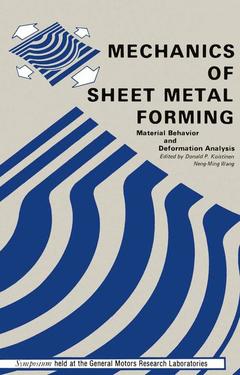Description
Mechanics of Sheet Metal Forming, 1978
Material Behavior and Deformation Analysis
Coordinator: Koistinen D.
Language: English
Keywords
computer; deformation; design; flow; friction; material; materials; mechanics; metals; plants; research; sheet metal forming; stamping; stress; technology
Publication date: 10-2011
416 p. · 17x24.4 cm · Paperback
416 p. · 17x24.4 cm · Paperback
Description
/li>Contents
/li>
This volume records the proceedings of an international symposium on "ME CHANICS OF SHEET METAL FORMING: Material Behavior and Deformation Analysis." It was sponsored and held at the General Motors Research Labora tories on October 17-18, 1977. This symposium was the twenty-first in an annual series. The objective of this symposium was to discuss the research frontiers in experimental and theoretical methods of sheet metal forming analysis and, also, to determine directions of future research to advance technology that would be useful in metal stamping plants. Metal deformation analyses which provide guide lines for metal flanging are already in use. Moreover, recent advances in computer techniques for solving plastic flow equations and in measurements of material parameters are leading to dynamic models of many stamping operations. These models would accurately predict the stresses and strains in the sheet as a function of punch travel. They would provide the engineer with the knowledge he needs to improve die designs. The symposium papers were organized into five sessions: the state of the art, constitutive relations of sheet metal, role of friction, sheet metal formability, and deformation analysis of stamping operations. We believe this volume not only summarizes the various viewpoints at the time of the symposium, but also pro vides an outlook for materials and mechanics research in the future.
Session I—State of the Art.- Chairman: W. Johnson, University of Cambridge.- Sheet Metal Stamping Technology—Need for Fundamental Understanding.- Discussion.- Experimental Studies of Material Behavior as Related to Sheet Metal Forming.- Discussion.- Plasticity Analysis of Sheet Metal Forming.- Discussion.- Session II—Constitutive Relations for Sheet Metal.- Chairman: E. H. Lee, Stanford University.- Plastic Deformation Behavior Under Conditions of Combined Stress.- Discussion.- Sheet Necking—I. Validity of Plane Stress Assumptions of the Long-Wavelength Approximation.- Sheet Necking—II. Time-Independent Behavior.- Discussion.- Session III—Role of Friction.- Chairman: J. J. Jonas, McGill University.- Friction and Lubrication in Sheet Metal Forming.- Discussion.- Drawbead Forces in Sheet Metal Forming.- Discussion.- Session IV—Instability Processes.- Chairman: S. S. Hecker, Los Alamos Scientific Laboratory.- Sheet Metal Forming Limits.- Discussion.- Limits to Ductility Set by Plastic Flow Localization.- Discussion.- Sheet Necking—III. Strain-Rate Effects.- Discussion.- Plastic Flow Properties in Relation to Localized Necking in Sheets.- Discussion.- Session V—Analysis of Deformation in Stamping Operations.- Chairman: B. Budiansky, Harvard University.- Deformation Analysis of Large Sized Panels in the Press Shop.- Discussion.- Deformation Analysis of Axisymmetric Sheet Metal Forming Processes by the Rigid-Plastic Finite Element Method.- Discussion.- Elastic-Viscoplastic Analyses of Simple Stretch Forming Problems.- Discussion.- Symposium Summary.- Participants.
© 2024 LAVOISIER S.A.S.




